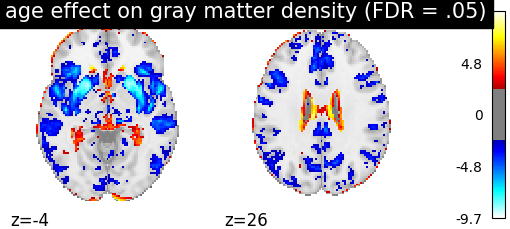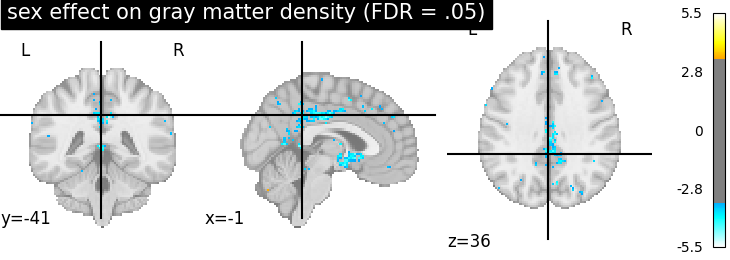Note
Click here to download the full example code or to run this example in your browser via Binder
Voxel-Based Morphometry on OASIS dataset#
This example uses voxel-based morphometry (VBM) to study the relationship between aging, sex, and gray matter density.
The data come from the OASIS project. If you use it, you need to agree with the data usage agreement available on the website.
It has been run through a standard VBM pipeline (using SPM8 and NewSegment) to create VBM maps, which we study here.
VBM analysis of aging#
We run a standard GLM analysis to study the association between age and gray matter density from the VBM data. We use only 100 subjects from the OASIS dataset to limit the memory usage.
Note that more power would be obtained from using a larger sample of subjects.
# Authors: Bertrand Thirion, <bertrand.thirion@inria.fr>, July 2018
# Elvis Dhomatob, <elvis.dohmatob@inria.fr>, Apr. 2014
# Virgile Fritsch, <virgile.fritsch@inria.fr>, Apr 2014
# Gael Varoquaux, Apr 2014
n_subjects = 100 # more subjects requires more memory
Load Oasis dataset#
from nilearn import datasets
oasis_dataset = datasets.fetch_oasis_vbm(
n_subjects=n_subjects,
legacy_format=False,
)
gray_matter_map_filenames = oasis_dataset.gray_matter_maps
age = oasis_dataset.ext_vars['age'].astype(float)
Sex is encoded as ‘M’ or ‘F’. Hence, we make it a binary variable.
sex = oasis_dataset.ext_vars['mf'] == 'F'
Print basic information on the dataset.
print(
'First gray-matter anatomy image (3D) is located at: '
f'{oasis_dataset.gray_matter_maps[0]}'
) # 3D data
print(
'First white-matter anatomy image (3D) is located at: '
f'{oasis_dataset.white_matter_maps[0]}'
) # 3D data
First gray-matter anatomy image (3D) is located at: /home/alexis/nilearn_data/oasis1/OAS1_0001_MR1/mwrc1OAS1_0001_MR1_mpr_anon_fslswapdim_bet.nii.gz
First white-matter anatomy image (3D) is located at: /home/alexis/nilearn_data/oasis1/OAS1_0001_MR1/mwrc2OAS1_0001_MR1_mpr_anon_fslswapdim_bet.nii.gz
Get a mask image: A mask of the cortex of the ICBM template.
Resample the mask, since this mask has a different resolution.
from nilearn.image import resample_to_img
mask_img = resample_to_img(
gm_mask,
gray_matter_map_filenames[0],
interpolation='nearest',
)
Analyse data#
First, we create an adequate design matrix with three columns: ‘age’, ‘sex’, and ‘intercept’.
import numpy as np
import pandas as pd
intercept = np.ones(n_subjects)
design_matrix = pd.DataFrame(
np.vstack((age, sex, intercept)).T,
columns=['age', 'sex', 'intercept'],
)
Let’s plot the design matrix.
from nilearn import plotting
ax = plotting.plot_design_matrix(design_matrix)
ax.set_title('Second level design matrix', fontsize=12)
ax.set_ylabel('maps')

Text(29.000000000000007, 0.5, 'maps')
Next, we specify and fit the second-level model when loading the data and also smooth a little bit to improve statistical behavior.
from nilearn.glm.second_level import SecondLevelModel
second_level_model = SecondLevelModel(smoothing_fwhm=2.0, mask_img=mask_img)
second_level_model.fit(
gray_matter_map_filenames,
design_matrix=design_matrix,
)
Estimating the contrast is very simple. We can just provide the column name of the design matrix.
z_map = second_level_model.compute_contrast(
second_level_contrast=[1, 0, 0],
output_type='z_score',
)
We threshold the second level contrast at FDR-corrected p < 0.05 and plot it.
from nilearn.glm import threshold_stats_img
_, threshold = threshold_stats_img(z_map, alpha=.05, height_control='fdr')
print(f'The FDR=.05-corrected threshold is: {threshold:03g}')
display = plotting.plot_stat_map(
z_map,
threshold=threshold,
colorbar=True,
display_mode='z',
cut_coords=[-4, 26],
title='age effect on gray matter density (FDR = .05)',
)
plotting.show()

The FDR=.05-corrected threshold is: 2.40175
We can also study the effect of sex by computing the contrast, thresholding it and plot the resulting map.
z_map = second_level_model.compute_contrast(
second_level_contrast='sex',
output_type='z_score',
)
_, threshold = threshold_stats_img(z_map, alpha=.05, height_control='fdr')
plotting.plot_stat_map(
z_map,
threshold=threshold,
colorbar=True,
title='sex effect on gray matter density (FDR = .05)',
)

<nilearn.plotting.displays._slicers.OrthoSlicer object at 0x7ff8eaea6230>
Note that there does not seem to be any significant effect of sex on gray matter density on that dataset.
Generating a report#
It can be useful to quickly generate a portable, ready-to-view report with most of the pertinent information. This is easy to do if you have a fitted model and the list of contrasts, which we do here.
from nilearn.reporting import make_glm_report
icbm152_2009 = datasets.fetch_icbm152_2009()
report = make_glm_report(
model=second_level_model,
contrasts=['age', 'sex'],
bg_img=icbm152_2009['t1'],
)
We have several ways to access the report:
# report # This report can be viewed in a notebook
# report.save_as_html('report.html')
# report.open_in_browser()
Total running time of the script: ( 3 minutes 44.282 seconds)
Estimated memory usage: 1111 MB